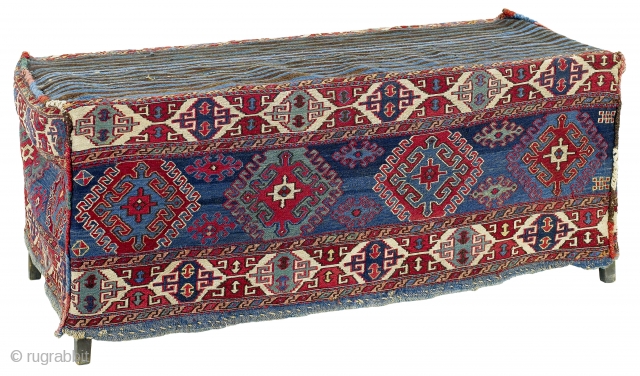Back
Second half 19th century South East Caucasus, Moghan region Called "mafrash", these large flatweaves with four sides and a kilim base were used by the Shahsavan nomads like containers for storing utensils, and they also served as cargo bags during the annual migrations to the summer pastures. Old photographs show camels carrying tall loads of mafrash containers. Mafrash lacking upper closure flaps, like this finely woven example in the sumakh technique, are usually attributed to the Moghan Shahsavan. The design of horizontal stripes, with a deep blue central band containing large hooked diamonds and two narrower white bands, has been conceived to continue along all four panels. – Very well preserved.Size 40 x 112 cm
Literature:
TANAVOLI, parviz, Shahsavan. Flachgewebe aus dem Iran. Herford 1985, no. 46 *** azadi, siawosch & andrews, peter, Mafrash. Gewebte Transporttaschen als textile Bilder des Orients-Arbeiten der Schahsavan und anderer Stämme Persiens. Berlin-Munich 1985, ill. p. 109
price:
On Request
- Home
- Antique Rugs by Region
- Category
- Profiles
- Post Items Free
- Albums
- Benaki Museum of Islamic Art
- Budapest: Ottoman Carpets
- Gulbenkian Museum
- Islamic Carpets. Brooklyn
- Islamic Textiles. Brooklyn
- Konya Museum: Rugs
- MKG, Hamburg
- MMA: Caucasian Carpets
- MMA: Mamluk Carpets
- MMA: Mughal Indian Carpets
- MMA: Ottoman Carpets
- MMA: Safavid Persian Carpets
- MMA: Turkmen Rugs
- McCoy Jones Kilims
- Ottoman textiles. Met
- Philadelphia Museum
- Rugs and Carpets: Berlin
- Seljuqs at the Met
- TIEM, Istanbul: Carpets
- V&A: Classical Carpets
- Vakiflar Carpets: Istanbul
- Baluch Rugs: Indianapolis
- Gallery Exhibitions
- Jaf an Exhibition
- Alberto Levi Gallery
- Andean Textile
- Christie's London: 2016
- Francesca Galloway
- HALI at 40
- ICOC Washington, DC 2018
- Jajims of the Shahsavan
- London Islamic Week April, 2018
- Mongolian Felts
- Navajo Rugs: JB Moore
- Persian Piled Weavings
- SF Tribal & Textile Art Show 2020
- SF Tribal 2019
- Sotheby's: C. Alexander
- Turkish Prayer Rugs
- Turkmen Main Carpets ICOC 2007











